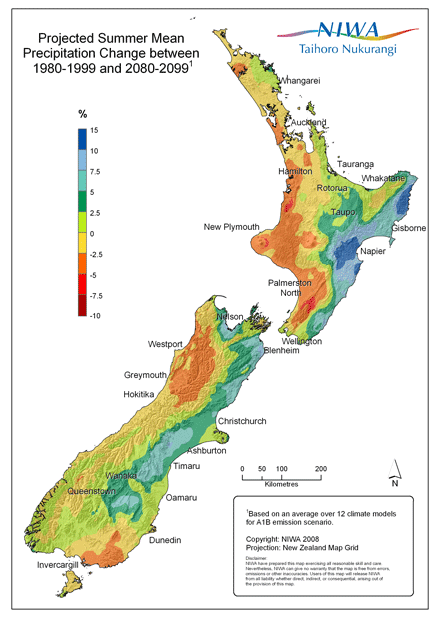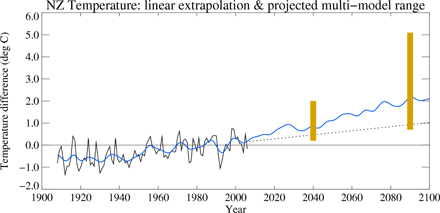 Hot off the presses: NIWA’s latest projections for the climate of New Zealand over the coming century were released this morning as part of a new MfE guidance manual (here, PDF) for local government. Based on IPCC modelling for AR3 and AR4 downscaled to local climate, plus early work with NIWA’s new regional climate model, the picture is broadly similar to earlier results: modest warming everywhere, a reduction in frosts and more hot days, increased frequency of droughts and heavy rainfall events, and steady sea level rise. NIWA’s press release is available at Scoop (link to full .doc here). At the same time the Ministry of Agriculture has released its latest EcoClimate report, which takes the new projections and assesses their impact on key agricultural sectors. I’ll be picking through these reports, and the associated coastal hazards guidance over the next few days, but here are a few of the headlines:
Hot off the presses: NIWA’s latest projections for the climate of New Zealand over the coming century were released this morning as part of a new MfE guidance manual (here, PDF) for local government. Based on IPCC modelling for AR3 and AR4 downscaled to local climate, plus early work with NIWA’s new regional climate model, the picture is broadly similar to earlier results: modest warming everywhere, a reduction in frosts and more hot days, increased frequency of droughts and heavy rainfall events, and steady sea level rise. NIWA’s press release is available at Scoop (link to full .doc here). At the same time the Ministry of Agriculture has released its latest EcoClimate report, which takes the new projections and assesses their impact on key agricultural sectors. I’ll be picking through these reports, and the associated coastal hazards guidance over the next few days, but here are a few of the headlines:
Using a mid range scenario (A1B) for emissions, NIWA projects a 2ºC warming for the 2090s. They note that this is about the difference in annual average temperature between Auckland and Wellington at the moment. The figure below (3.2b in the guidance manual) shows NZ temperatures plotted against the 1980-99 mean.

The black line is observed temperatures from the early 1900s on, and the blue line is a smoothed version, showing decadal variations in the past, and how the modelling projects those variations forward for that mid range scenario. The two orange bars represent the full range of temperature projections derived from all the modelling (and all the emissions scenarios) for the 2030s and the 2090s, the two main focus points for the report. The lower bounds of these bars is close to a linear projection based on past temperatures (the dotted line), but the upper limits – based on high emissions scenarios – suggests 2ºC by the 2030s and as much as 5ºC by the 2090s. One interesting conclusion here is that the warming will accelerate a little over coming decades when compared with the recent past, but that decadal variations could still lead to runs of warm and cool years. There’s an interesting discussion of the Interdecadal Pacific Oscillation(IPO), and its impact on ENSO/El Niño/La Niña and NZ climate in section 3.2. One possibility is that with the IPO currently in its negative phase, the frequency of La Niña events will increase and NZ will have a run of warm years.
Another very interesting suggestion emerging from the new modelling is that there may be marked changes in the seasonal distribution of rainfall. In the 2004 projections it was expected that a general strengthening of the westerly airflow over the country would lead to increased rainfall in the west and some reductions on the east coast throughout the year. Some models now suggest that in summer and autumn the westerlies may decrease in strength, allowing more easterly airflows to increase east coast rainfall. Click on the map that’s thumbnailed at the top of this post. It shows rainfall projections for summer in the 2090s, and marked increases in the east, particularly of the North Island. NIWA aren’t so confident about this result – it’s not showing up in all the modelling – but it does demonstrate that regional uncertainties can be larger than national averages might suggest.
More analysis will follow over the next few days.

I see that the EcoClimate report is being reliably misreported. Compare the Herald’s headline: Climate change to benefit farmers – report with the actual findings:
For average years, the projections show no strong increase or decrease during the coming century in production when averaged over the whole country. Projected national dairy production ranges from 96 to 101%, and projected sheep/beef production from 91 to 96% of the 1972–2002 average.
Some “benefit”. And that’s only on page 5 of the summary, or page 2 of the actual report. But I guess they just couldn’t be bothered reading that far…
A cynic (who, me?) might suggest that the media is keen on a “silver lining” now that Key’s dropped the ETS…
(I’m scheduled to be interviewed on this by Marcus Lush on Radio Live at 7-20am… No sleep for the wicked. Thanks, Ben. )